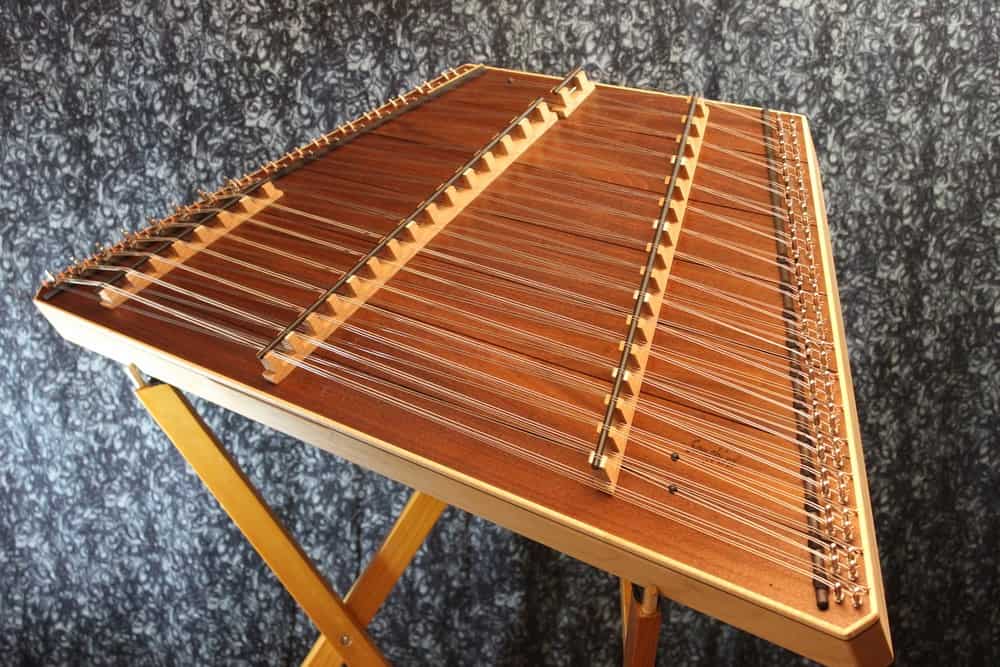May 11, 2020

Wood is constantly in motion. The technical term is hygroscopic, meaning it will absorb or release water based on the relative humidity at the time. As it absorbs or releases the water it shrinks or swells across the grain but not along the grain. This means your dulcimer can be affected by the amount of water in the air, causing its construction to shift and thus change the sound of your instrument.
The amount of change can be quite a lot. We have a 20-inch wide coffee table that I built from 150-year-old salvaged walnut. Since it has bread board ends we can see how much it moves from the wet of summer to the dry of winter, and it is almost 1/4 inch. All woods move like this, some less than others.
This poses a problem for hammered dulcimer builders, but there are several ways to get around it:
- 1). Just build them from plywood (Songbird Phoebe or Chickadee models, Dusty Strings Prelude, Apprentice, etc.) which is locked and doesn’t move much due to the construction of the material.
- 2.) Floating top dulcimers (Cloud Nine, David Lindsey Grand, etc) are built with the top not glued to the frame so it is free to shrink or swell as it needs to. The drawback to this is they are quite heavy since the top is not part of the physical structure that keeps the dulcimer from folding up under all that string tension.
- 3.) Build the dulcimer in a controlled humidity environment with the wood at a stable moisture content before gluing to the frame (Masterworks, Dusty Strings, older Songbird Warbler and Whippoorwill models) then make it the buyer’s responsibility to protect their instrument from extremes.
- 4.) Or build them like the dulcimer in the photo above (Songbird Finch and Sparrow models) with the top composed of individual narrow boards joined by tight-fitting tongue and groove joints that are not glued allowing each board to move freely as it needs to with humidity changes. The boards are glued to the pin blocks at the end but the glue has enough flexibility to let them move so the whole system works very well.
If dulcimers with wide solid wood tops are subjected to changes in humidity it puts stress on the instrument. If the weather is too dry, the top can crack. Dulcimer wood is going to shrink and it will relieve that stress somehow. Changes as simple as going from normally humid summer to normally dry winter.
Most builders of non-floating top dulcimers recommend that you keep your dulcimer in a humidified environment in winter. This can be a problem, though. If you have your dulcimer safely humidified, then go to play somewhere where there is not added humidity, it will go out of tune quickly.
For all our current models, we recommend that you do not try to control the humidity around your dulcimer. Just let it get used to the environment of the time and it will be more stable. Small changes in humidity won’t throw it out of tune and it’ll be a much happier instrument. Just keep it in tune and enjoy it. Don’t worry about heat, humidity, or dryness, it’ll take them in stride and just be a loyal friend, not be a problem.
5 Comments
-
I live in Denver. My dulcimer has developed a kind of roar or sympathetic sounding of the strings. Someone told me it the sound might be because of the low humidity here in Denver. Does that make sense? I cannot get the humidity in the room above about 31%.
-
We are thinking of buying a used Songbird Warbler that’s been in Iowa since at least 2013. We live in Colorado – a massive difference in humidity.
We’re concerned that this big shift may cause problems for the instrument. Do you recommend us finding one coming from a drier climate instead?
-
Thank you so much!
